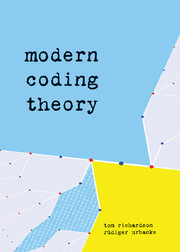Book contents
- Frontmatter
- Contents
- PREFACE
- 1 INTRODUCTION
- 2 FACTOR GRAPHS
- 3 BINARY ERASURE CHANNEL
- 4 BINARY MEMORYLESS SYMMETRIC CHANNELS
- 5 GENERAL CHANNELS
- 6 TURBO CODES
- 7 GENERAL ENSEMBLES
- 8 EXPANDER CODES AND FLIPPING ALGORITHM
- A ENCODING LOW-DENSITY PARITY-CHECK CODES
- B EFFICIENT IMPLEMENTATION OF DENSITY EVOLUTION
- C CONCENTRATION INEQUALITIES
- D FORMAL POWER SUMS
- E CONVEXITY, DEGRADATION, AND STABILITY
- Authors
- Index
C - CONCENTRATION INEQUALITIES
Published online by Cambridge University Press: 05 September 2012
- Frontmatter
- Contents
- PREFACE
- 1 INTRODUCTION
- 2 FACTOR GRAPHS
- 3 BINARY ERASURE CHANNEL
- 4 BINARY MEMORYLESS SYMMETRIC CHANNELS
- 5 GENERAL CHANNELS
- 6 TURBO CODES
- 7 GENERAL ENSEMBLES
- 8 EXPANDER CODES AND FLIPPING ALGORITHM
- A ENCODING LOW-DENSITY PARITY-CHECK CODES
- B EFFICIENT IMPLEMENTATION OF DENSITY EVOLUTION
- C CONCENTRATION INEQUALITIES
- D FORMAL POWER SUMS
- E CONVEXITY, DEGRADATION, AND STABILITY
- Authors
- Index
Summary
Asserting a specific property about an individual code is typically a hard task. To the contrary, it is often easy to show that most codes in a properly chosen ensemble possess this property. In the realm of classical coding theory an important such instance is the minimum distance of a code. For Elias's generator ensemble G a few lines suffice to show that with high probability an element chosen uniformly at random has a relative minimum distance of at least δGV, where δGV is the Gilbert-Varshamov distance discussed on page 7. But as mentioned on page 33, it is known that the corresponding decision problem – whether a given code has relative minimum distance at least δGV – is NP-complete.
We encounter a similar situation in the realm of message-passing decoding. The whole analysis rests on the investigation of ensembles of codes and, therefore, concentration theorems which assert that most codes in this ensemble behave close to the ensemble average are at the center of the theory. There is one big difference though which makes concentrations theorems invaluable for message-passing decoding, whereas in the classical setting they only play a marginal role. The main obstacle which we encounter in classical coding is that a random code (in G) is unlikely to have an efficient decoding algorithm, and, therefore, a random code is unlikely to be of much practical value. In the message-passing world the choice of the ensemble (e.g., LDPC, turbo, multi-edge, etc.) guarantees that every element can be decoded with equal ease.
- Type
- Chapter
- Information
- Modern Coding Theory , pp. 479 - 504Publisher: Cambridge University PressPrint publication year: 2008

